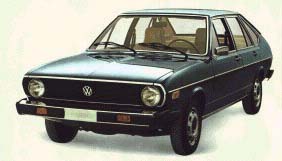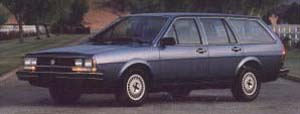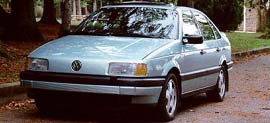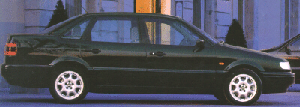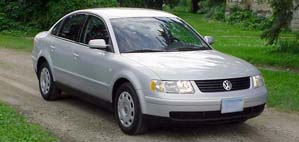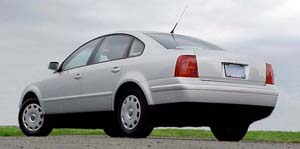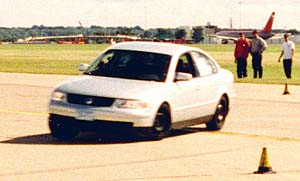
VW volkswagen
Passat
CHIPS - PASSAT
ABT
AMS
Garret
P-Chip
Superchips
Techtonics
Wetterauer
The Volkswagen Passat is a midsized car built by Volkswagen AG. It falls between the VW Golf/Jetta and VW Phaeton in the current VW production line-up. It is produced in VW's plant in Emden.
B2
The original Passat was launched in 1973. The Passat was designed by Giorgetto Giugiaro, who followed this design with the Lamborghini Espada, which can stylistically be viewed as a Passat supercar.
It was essentially a rebadged Audi 80, with the exception that the Passat was a large hatchback or wagon while the Audi was only available as a sedan. The Passat was Wheels magazine's Car of the Year for 1974. Later, a station wagon was added to the range, and rapidly became the most widespread production version. Engine capacities were either 1600 or 1800cc, with a very small number of vehicles having a 2000cc engine near the end of production.
The Passat used an inline 4-cylinder OHC engine, longitudinally mounted with front wheel drive, in Audi tradition. In the United States, it was called the Volkswagen Dasher. This generation was sold in Brazil well into the 1980s, and VW do Brasil also exported completely knocked-down kits to Nigeria for local assembly. It was also extensively exported to Iraq, where many are still on the road.
B3
This basic design continued until 1981, when the Passat was lengthened slightly and freshened, and a sedan version known as the Volkswagen Santana was introduced. This second-generation sedan is still built in China, with a major facelift, as the Volkswagen Santana 2000. They were also built in Brazil as the Santana and the Quantum station wagon (the latter being the name of this entire range in the U.S. between 1982 and 1988), with twin models from Ford (the Ford Versailles, which included an unusual three-door station wagon called the Ford Royale) as part of the Autolatina venture.
B4
The third-generation Passat appeared in 1987 (1989 in North America), and was based largely on the Golf. The engine was turned around to transverse "east-west" configuration, and the floorpan was engineered to accept VW's "Syncro" four-wheel drive system. Volkswagen's new VR6 engine was also made available in 1991. Only sedan and station wagon versions were available. This version of the Passat was facelifted in 1993.
B5
The current Passat was launched in 1996, and was significant in that it returned to Audi underpinnings, again using the classic "overhung" longitudinally mounted engine with front wheel drive. All wheel drive was later introduced as an option, using a Torsen center differential for superior handling on slick surfaces. The B5 Passat shared its platform with the Audi A4, though the latter was redesigned and received a new platform in 2002. The most notable thing about the B5 Passat was its good handling, which was as good as anything produced by Mercedes-Benz or BMW. This was the first step of VW moving its products upmarket, with SEAT and Skoda taking over as the "budget" brands. In mid 2000 the Passat received a minor tweaking of styling and some mechanics.
This model was introduced to the US in 1998 and came with came with either a 1.8 L turbocharged 4 cylinder, or 2.8 L 6 cylinder engine and a 5 speed manual or 5 speed automatic transmission. The 1.8 L in the Passat and Audi A4 has a lower oil capacity than transverse applications of the same engine, and suffers from oil sludge problems as a result. A 4.0 L W8 engine producing 275 hp was introduced in 2001 in an upmarket version of the car that included all wheel drive standard, but this was a slow seller and the engine was retired in 2004. In 2004 a 2.0 turbocharged diesel TDI engine was added to the US lineup, making the Passat the only midsized diesel powered car sold in the US.
A long-wheelbase version was offered in China. The lengthened platform went on to underpin the Skoda Superb in western markets.
Next Generation
The next-generation Passat was displayed at the Geneva Motor Show in March of 2005. It features a 200 hp 2.0 L turbocharged I4 as the base engine, or a 280 hp 3.6 L VR6 engine as the upgrade and six-speed manual and automatic transmissions. The new "B6" Passat features a return to the transversely mounted engine and no longer shares its platform with the Audi A4.
The expensive Torsen center differential is lost, being replaced with the less-expensive Haldex multi-plate clutch. This will cause the car to handle more like a 2wd, with understeer and better fuel economy. Unlike the Torsen, which helps avoid loss of traction by using a 50:50 power distribution under normal conditions, the Haldex can only respond after slippage has occurred. It does this with a jolt which may cause the remaining wheels with traction to lose their grip. The Haldex can direct power more unequally that the Torsen, which is limited to 66:34 or 34:66 in the B5 Passat. This may help with extraction from deep sand, although the Passat is far from being an off-road vehicle.
The 4-link front suspension, designed to eliminate torque steer, is also lost.
Technical Specifications
2001 Passat GLS V6 Sedan (North America)
- Engine Type: 2.8l, 6-cylinder, 30-valve, 90° V
- Power (SAE): 190 hp (142 kW) @ 6000 rpm
- Torque: 206 lb-ft (280 Nm) @ 3200 rpm
- Redline: 6500 rpm
- Bore & Stroke: 3.25 by 3.40 in (82.5 by 86.4 mm)
- Displacement: 169.1 in³ (2771 cm³)
- Compression ratio: 10.6:1
- Arrangement: Front mounted, longitudinal
- Cylinder Block: Cast iron
- Crank Shaft: Forged steel, four main bearings
- Cylinder head: Aluminum alloy, cross flow
- Valve Train: Double overhead camshaft with variable intake valve timing, spur belt driven, 5 valves per cylinder, maintenance-free hydraulic lifters
- Cooling System: Water cooled, water pump, cross flow radiator, thermostatically controlled electric radiator fan
- Lubrication: Rotary gear pump, oil cooler
- Fuel/Air Supply: Sequential multi-point fuel injection (Motronic ME7), variable intake manifold geometry
- Emissions: OBD II, LEV, two 3-way precatalytic converters and two main cats with four oxygen sensors (upstream and downstream)
- Transmission: 5-speed Manual
- Transmission Ratios:
- 1st 3.50:1
- 2nd 1.94:1
- 3rd 1.30:1
- 4th 0.94:1
- 5th 0.79:1
- Reverse 3.44:1
- Final Drive 3.70:1
- Front Suspension: Four link suspension, coil springs, telescopic shock absorbers, stabilizer bar
- Rear Suspension: Independent torsion beam axle with trailing arms, coil springs, telescopic shock absorbers, stabilizer bar
- Steering type: Rack and pinion, power assisted
- Steering Wheel turns: 2.80 lock-to-lock
- Turning Circle: 37.4 ft (11.4 m) curb-to-curb
- Steering ratio: 14.3 : 1
- Wheels: 7J x 15 in (381 mm) Cast Aluminum "Adelaide"
- Original Tires: Michelin Energy MXV4 Plus P195/65R15 H-rated
- Braking System: Power assisted, dual circuit
- Front Discs: Ventilated, 282.5 by 25 mm (11.1 by 1 in)
- Rear Discs: Solid, 245 by 10 mm (9.6 by 0.4 in)
- Parking Brake: Rear, mechanical
- Anti-lock braking system: Bosch 5.3, all four wheels
- Wheelbase: 106.4 in (2703 mm)
- Track, front: 59.0 in (1499 mm)
- Track, rear: 59.1 in (1501 mm)
- Length: 184.1 in (4676 mm)
- Width: 68,5 in (1740 mm)
- Height: 57.6 in (1463 mm)
- Ground Clearance: 4.3 in (109 mm)
- Curb Weight: 3151 lb (1432 kg)
- Payload: 1005 lb (457 kg)
External links
- VW Germany: Passat (http://showrooms.volkswagen.de/vwcms_publish/vwcms/master_public/showrooms/de/passat.frameset_outer.html)
- VW of America: Passat (http://www.vw.com/passat/)
- VW UK: Passat (http://www.vw.co.uk/new_cars/passat_saloon_noflash)
- VWPassat Yahoo Group (mailing list) (http://autos.groups.yahoo.com/group/vwpassat/)
- History of the Passat (http://www.visi.com/~bhjelt/history.html)
www.visi.com
|
History of the Passat VW's Passat is the largest car in their lineup. While the European Passats have always kept the Passat name, the US market has had a few name changes since the first Passat. In the US, the Passat was first introduced as the Dasher. Then came the Quantum/Santana. And for the last three generations VW's largest car has been named Passat. Launched in 1973, the Dasher was the replacement for the 1600 series. The top of the line Passat TS featured an 85HP water-cooled 1.5L four-cylinder motor with an overhead camshaft driving the front wheels. This Dasher was good for 0-100KM/h in 12 seconds with a top speed of 105 MPH. Getting 23.5 MPG it was pretty economical too, perfect for the oil crisis. The Dasher got a facelift in fall 1977 along with a few improvements including all motors were equipped with hardened valve seats so they could run unleaded fuel. |
|
|
|
|
|
For 1988, VW presented the world with the third generation Passat, although it wasn't readily available in the US until 1990. This model is easily identified by its lack of a front grill. The 1990 B3 Passat came standard with the 2.0L 16V motor. Rated at 134HP and 133lbs/ft torque it was capable of 0-60MPH in 9.8 seconds and could go on to a top speed of 125MPH. One cool feature of the B3 Passat was the adjustable rear seats. While the B3 Passat compared favorably to it's Japanese and American competitors, it never was able to keep up in sales volume. There are a lot of loyal B3 owners though, something that the Americans and Japanese can't say. For 1991(1992 US), the Passat was the first VW to receive the all-new VR6 motor. With 172 HP on tap, it made the 5 speed Passat go 0-60MPH in 7.9 seconds. |
|
|
|
|
| B5 Passats were first introduced in 1998 and were initially available only in the base GLS model with the 1.8t motor. Soon thereafter a GLX model with the Audi 30V V6 came along and the GLS V6. The B5 Passat is based off of the same platform as the Audi A4 and Audi A6. It even shares the 1.8t I4 and 30V V6 with the Audi models. The newest Passat has a five valve per cylinder dual over-head cam (V6 with variable valve timing) longitudinally mounted engine that drives the front wheels. It has a multilink front suspension that is designed to effectively eliminate torque steer, while the rear gets a torsion beam setup. Standard equipment includes driver and front passenger front and side airbags, ABS, electronic differential lock, power windows, locks, heated power mirrors, factory alarm, MFA, AM/FM Cassette stereo with 8 speakers, and CFC free air conditioning. A power glass sunroof, heated seats, and a five-speed tiptronic auto transmission are options. For 1999 the Passat got the new blue and red dashboard lighting. The hot setup for B5's? 1.8 turbo 5speed with a performance chip: 190-200HP, 230-255lb/ft of torque. |
|
Acura //// Audi //// Austin-Healey //// BMW //// Buick //// Cadillac //// Chevrolet //// Chrysler
Daihatsu //// Dodge //// Eagle //// Ford //// General Motors Corporation //// Geo //// Honda //// Hyundai //// Infiniti
Isuzu //// Jaguar //// Jeep //// Jensen-Healey //// Kia //// Lexus //// Lincoln //// Mazda //// Mercedes Benz //// Mercury //// MG //// Mini
Mitsubishi //// Nissan //// Oldsmobile //// Plymouth //// Pontiac //// Rolls-Royce //// Rover //// Saab //// Saturn //// Subaru //// Suzuki //// Toyota //// Triumph //// Volvo //// VW



